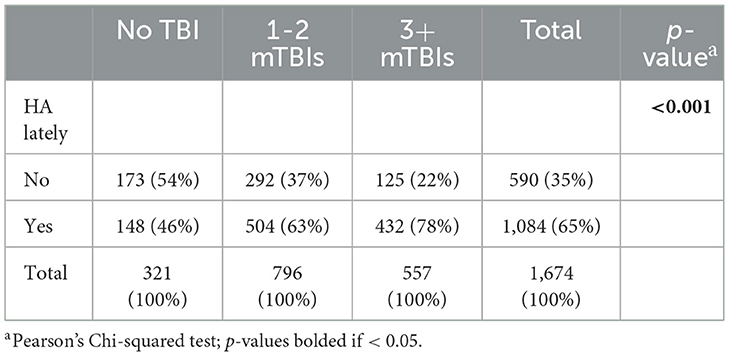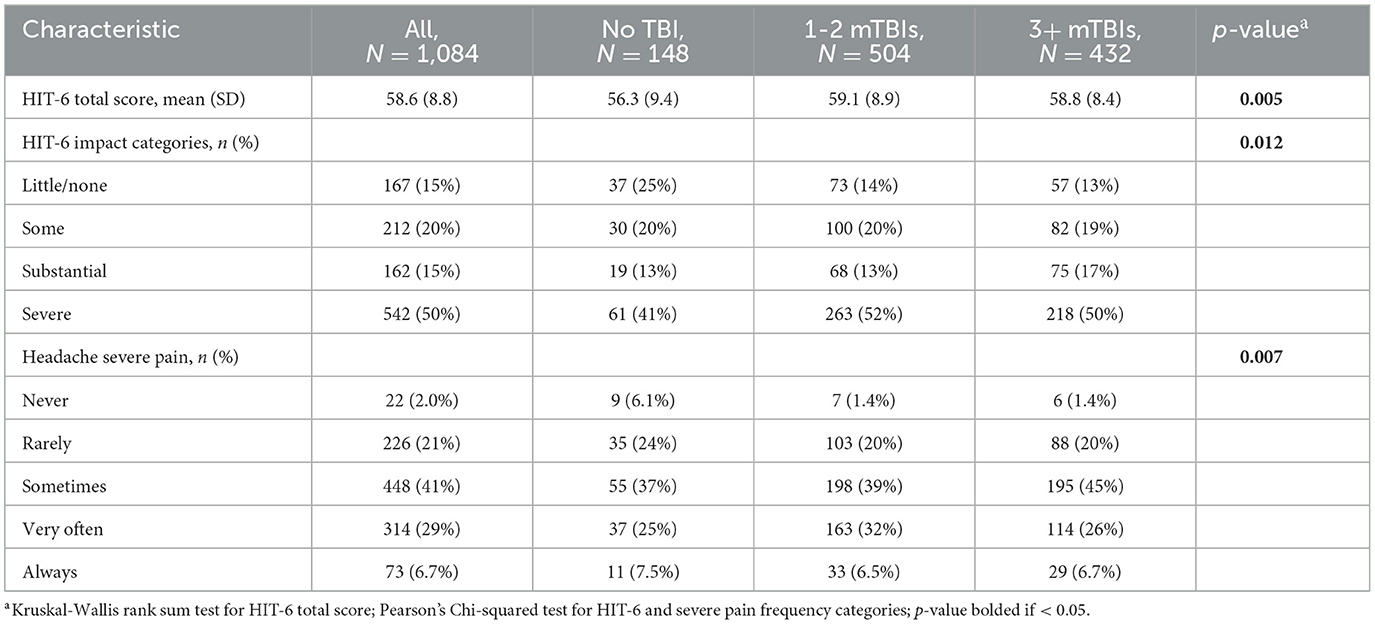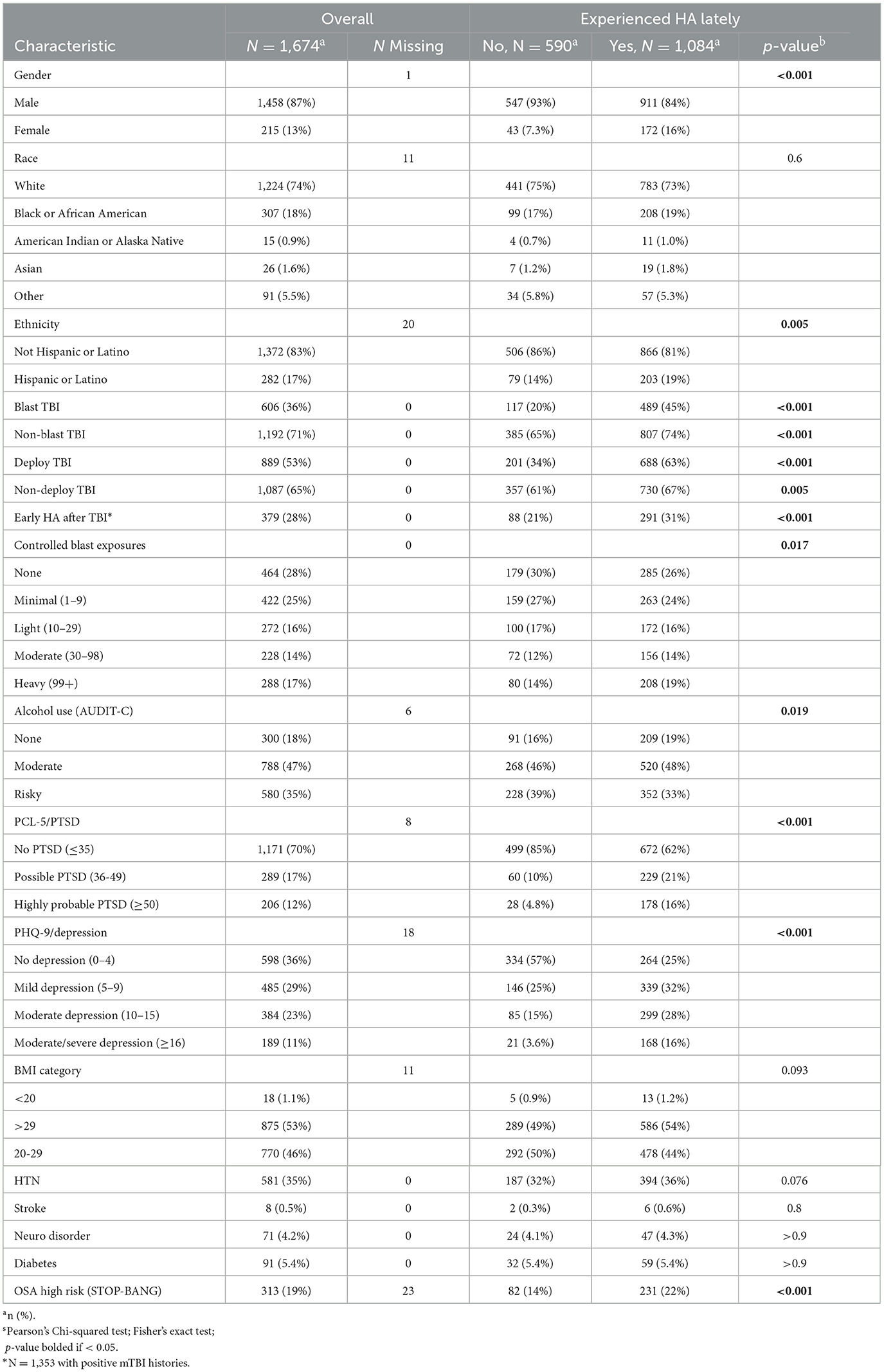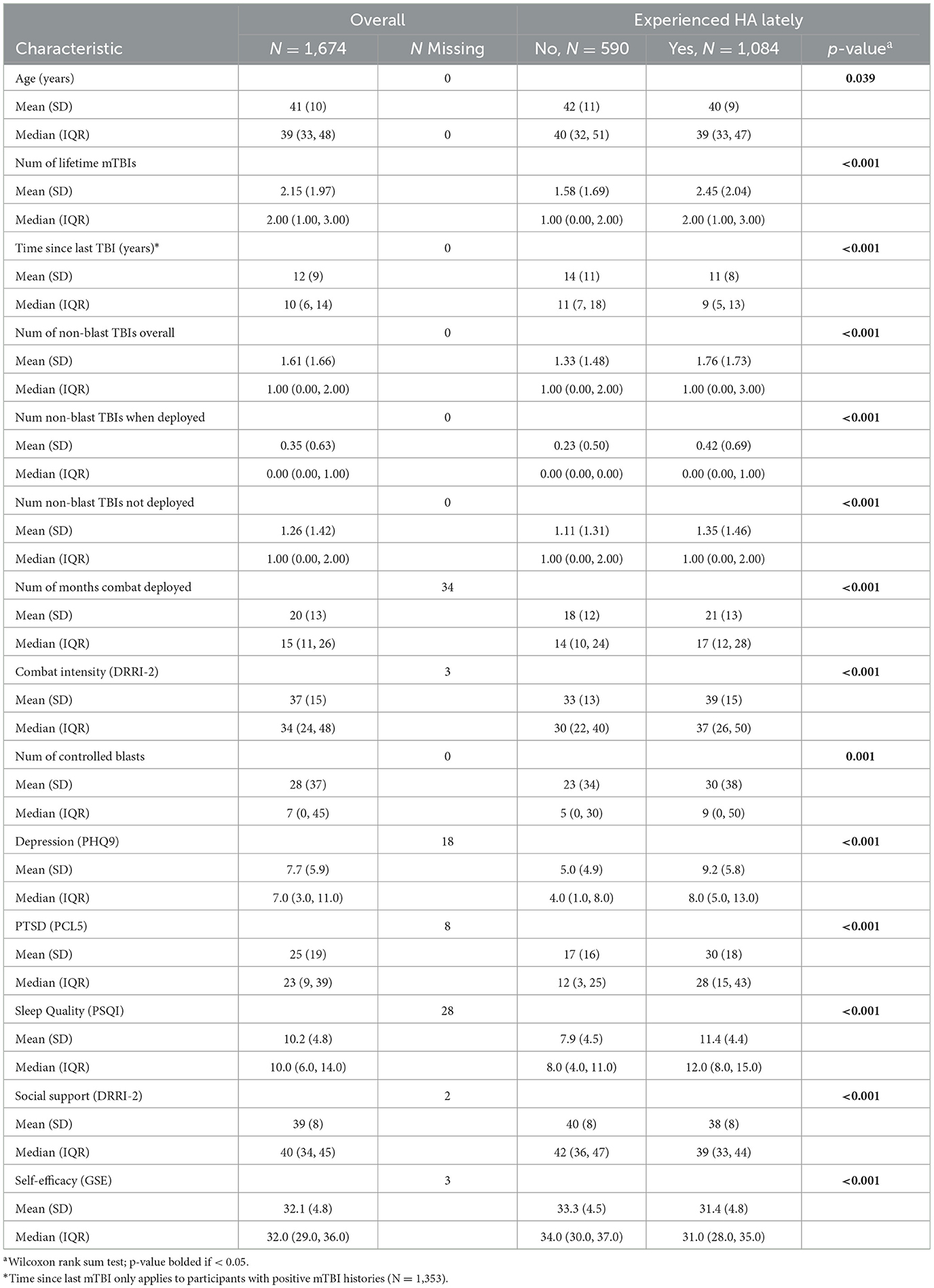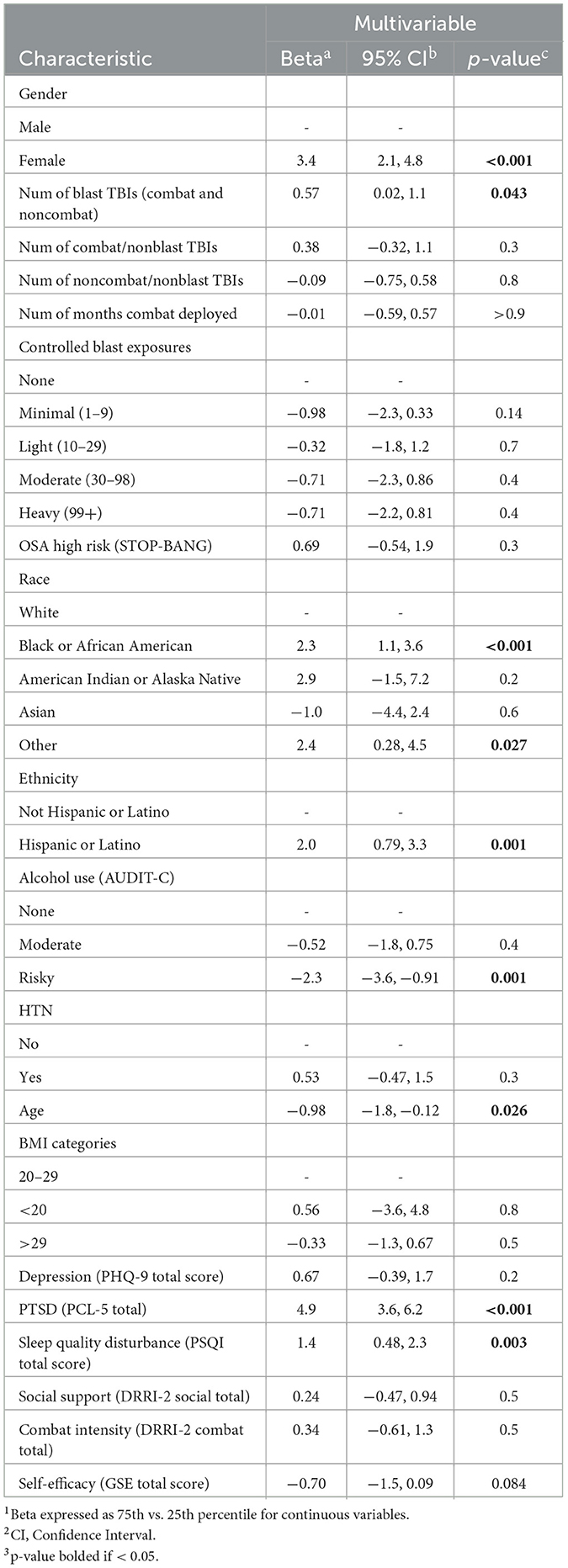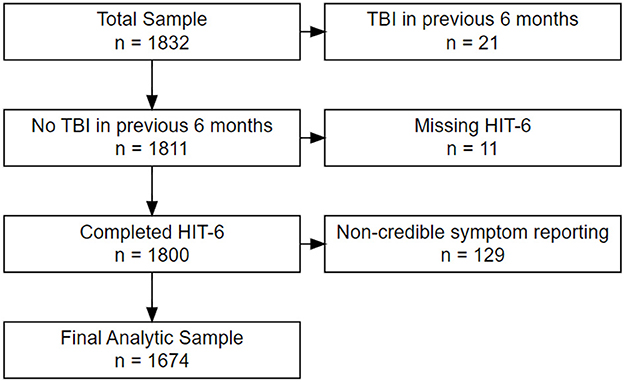- 1Department of Physical Medicine and Rehabilitation (PM&R), School of Medicine, Virginia Commonwealth University, Richmond, VA, United States
- 2Richmond Veterans Affairs (VA) Medical Center, Central Virginia VA Health Care System, Richmond, VA, United States
- 3Division of Epidemiology, Department of Internal Medicine, University of Utah, Salt Lake City, UT, United States
- 4George E. Wahlen VA Salt Lake City Healthcare System, Salt Lake City, UT, United States
- 5Department of Neurology, Traumatic Brain Injury and Concussion Center, University of Utah, Salt Lake City, UT, United States
- 6Mental Health and Behavioral Science Service, James A. Haley Veterans' Hospital, Tampa, FL, United States
- 7Department of Psychiatry and Behavioral Neurosciences, University of South Florida, Tampa, FL, United States
- 8Department of Neurology, University of Utah, Salt Lake City, UT, United States
- 9Informatics, Decision-Enhancement, and Analytic Sciences (IDEAS) Center, Salt Lake City, UT, United States
- 10Department of Internal Medicine, Division of Epidemiology, Spencer Fox Eccles School of Medicine, University of Utah, Salt Lake City, UT, United States
- 11Department of Neurology, Uniformed Services University of the Health Sciences, Bethesda, MD, United States
A Corrigendum on
Headache among combat-exposed veterans and service members and its relation to mild traumatic brain injury history and other factors: a LIMBIC-CENC study
by Walker, W. C., Clark, S. W., Eppich, K., Wilde, E. A., Martin, A. M., Allen, C. M., Cortez, M. M., Pugh, M. J., Walton, S. R., and Kenney, K. (2023). Front. Neurol. 14:1242871. doi: 10.3389/fneur.2023.1242871
In the published article, there was an error in “Figure 1. Study Sample Inclusion Flow Diagram”. After publication, the authors were informed that one site's IRB retroactively deemed their data to be invalid, and therefore cannot be published (Site #10; Eisenhower Army Medical Center; located near Augusta, GA). The updated figure reflects changes excluding the removed data and updated the results data in all main Tables and supplementary Tables; Table 1. Headache (HA) prevalence (experienced HA lately) stratified by # lifetime mTBIs; Table 2. Headache (HA) impact stratified by # lifetime mTBIs; Table 3. Post-hoc comparisons of HIT-6 headache severity categories by # lifetime mTBIs; Table 4. Categorical covariates stratified by absence/presence of Headache (HA); Table 5. Continuous covariates stratified by absence/presence of Headache (HA); Table 6. Multivariable logistic regression—experience headaches lately yes/no; Table 7. Multivariable linear regression for HIT-6 total score (multiple R2 = 0.350).
In the article, there were errors in the following supplementary tables as published. Supplementary Table 1. Post-hoc comparisons HIT-6 Total Sore by Number of mild TBI groups; Supplementary Table 2. Post-hoc comparisons of HIT-6 Impact categories by Number of mild TBI groups; Supplementary Table 3. Prevalence of Headache Lately; Logistic regression sensitivity analysis including only mTBI positive participants (N = 1,234); Supplementary Table 4. Headache Impact (HIT6 Total Score); Linear Regression sensitivity analysis including only mTBI positive participants who endorsed HA Lately (N = 853).
In the published article, there were errors in the Abstract, Methods and Results sections as published. They should have been written as:
Methods: Participants with non-credible symptom reporting were excluded, leaving N = 1,674 of whom 81% had positive mTBI histories.
Results: In covariate-adjusted analysis, HA prevalence was higher with greater number of blast-related mTBIs (OR 1.81; 95% CI 1.48, 2.23) non-blast mTBIs while deployed (OR 1.42; 95% CI 1.14, 1.79), or non-blast mTBIs when not deployed (OR 1.23; 95% CI 1.02, 1.49).
In the published article, there were errors in the Methods, Participants section as published. This should have been written as:
For this secondary analysis, all LIMBIC-CENC PLS participants whose enrollment (baseline) assessment data were available at time of dataset extraction were included (n = 1,832). …. We also excluded participants with evidence of noncredible symptom reporting based on failing (126) the Mild Brain Injury Atypical Symptom (mBIAS) scale, a validated self-reported measure of symptom reporting credibility in the mTBI population using the developer's recommended cut-point of 8 or higher (Cooper et al., 2011). This left a final analytic sample of 1,674 participants (see Figure 1).
In the published article, there were errors in the Results section as published. This should have been written as:
In our final sample of 1,674 combat-exposed current and former SMs, 19% had an entirely negative lifetime mTBI history, 47% had sustained 1-2 mTBIs, and 34% had 3 or more. Rates of positive history across the mTBI mechanism/setting categories were 63% for Combat mTBI(s), 67% for Non-combat mTBI(s), and 37% for Blast-related mTBI(s).
In the published article, there were errors in the Results, HA prevalence and impact across mTBI history groups (0, 1–2, 3+) section as published. This should have been written as:
For example, the rate of severe HA pain sometimes, often or always was 70% for the no TBI group compared to 78% for those with 1-2 or 3+ lifetime mTBIs. (See Table 3 for HIT-6 item #1 post-hoc testing; the other post-hoc testing data are available in Supplementary Tables S1, S2).
In the published article, there were errors in the Results, Main multivariable regression analyses section as published. This should have been written as:
For TBI history, the number of lifetime mTBIs of every type was significant, including blast-related (OR = 1.80), Blunt during combat-deployment (OR = 1.41), and Blunt outside of deployment (OR = 1.23). Other significant factors included identifying as female (OR = 3.57), age (0.76), total months combat-deployed (OR = 1.23), and symptoms of depression on PHQ-9 (OR = 1.56), PTSD on PCL-5 (OR = 1.54), and disturbed sleep quality on PSQI (OR = 1.78).
For TBI history, only blast-related mTBIs were significant (Beta 0.57). Blunt-only mTBIs did not reach significance, regardless of contextual type (combat or non-combat). Other factors found significant in the HIT-6 linear regression that were also significant in the HA prevalence logistic regression were female identity (Beta 3.4), younger age (Beta −0.98), PTSD symptoms (Beta 4.9), and reduced sleep quality (Beta 1.4). Demographic characteristics that were significant in the HIT-6 score linear regression model but not the preceding HA prevalence model were Black racial identity (Beta 2.3) and Hispanic/Latino ethnic identity (Beta 2.0) as compared with White/non-Hispanic racial/ethnic identity.
In the published article, there were errors in the Discussion section as published. This should have been written as:
Discussion
The overall sample (n = 1,674), which included 19% with negative TBI histories, had a HA point prevalence (i.e., HA lately) of 65%.
The covariate-adjusted logistic regression model for HA prevalence (see Table 6) showed higher prevalence with a greater number of any subtype of mTBI (see Table 6), with the nominally highest OR for blast-related mechanism (OR 1.80; 95% CI 1.47, 2.22).
Our large sample, which included 215 females (13%), enabled us to examine their relative risk for HA, a previously understudied research question in the military population due to insufficient numbers of females in most prior HA studies. Our results show that female sex had the nominally highest OR (3.57; 2.37, 5.48) for experiencing HA lately (see Table 6), and had a strong association with higher HA impact (Beta 3.4; 2.1, 4.8; see Table 7).
In the published article, there were errors in the Discussion, Study strengths section as published. This should have been written as:
Study strengths included our large sample (n = 1,674) of individuals with military combat exposure drawn from the LIMBIC-CENC multicenter cohort with rigorously determined lifetime mTBI histories and a large breadth of data available from their comprehensive assessments.
The authors apologize for this error and state that this does not change the scientific conclusions of the article in any way. The original article has been updated.
Publisher's note
All claims expressed in this article are solely those of the authors and do not necessarily represent those of their affiliated organizations, or those of the publisher, the editors and the reviewers. Any product that may be evaluated in this article, or claim that may be made by its manufacturer, is not guaranteed or endorsed by the publisher.
Keywords: traumatic brain injury, concussion, headache, postconcussive headache, veterans, blast injuries, military medicine, prediction
Citation: Walker WC, Clark SW, Eppich K, Wilde EA, Martin AM, Allen CM, Cortez MM, Pugh MJ, Walton SR and Kenney K (2025) Corrigendum: Headache among combat-exposed veterans and service members and its relation to mild TBI history and other factors: a LIMBIC-CENC study. Front. Neurol. 16:1577480. doi: 10.3389/fneur.2025.1577480
Received: 15 February 2025; Accepted: 28 March 2025;
Published: 16 April 2025.
Edited and reviewed by: Sergio Bagnato, Provincial Agency for Health Services (APSS) of Trento, Italy
Copyright © 2025 Walker, Clark, Eppich, Wilde, Martin, Allen, Cortez, Pugh, Walton and Kenney. This is an open-access article distributed under the terms of the Creative Commons Attribution License (CC BY). The use, distribution or reproduction in other forums is permitted, provided the original author(s) and the copyright owner(s) are credited and that the original publication in this journal is cited, in accordance with accepted academic practice. No use, distribution or reproduction is permitted which does not comply with these terms.
*Correspondence: William C. Walker, d2lsbGlhbS53YWxrZXJAdmN1aGVhbHRoLm9yZw==
 William C. Walker
William C. Walker Sarah W. Clark
Sarah W. Clark Kaleb Eppich
Kaleb Eppich Elisabeth A. Wilde
Elisabeth A. Wilde Aaron M. Martin
Aaron M. Martin Chelsea M. Allen3
Chelsea M. Allen3 Melissa M. Cortez
Melissa M. Cortez Mary Jo Pugh
Mary Jo Pugh Kimbra Kenney
Kimbra Kenney